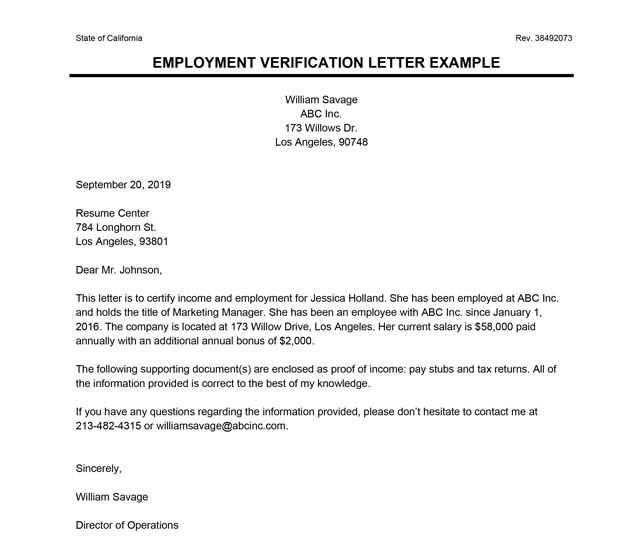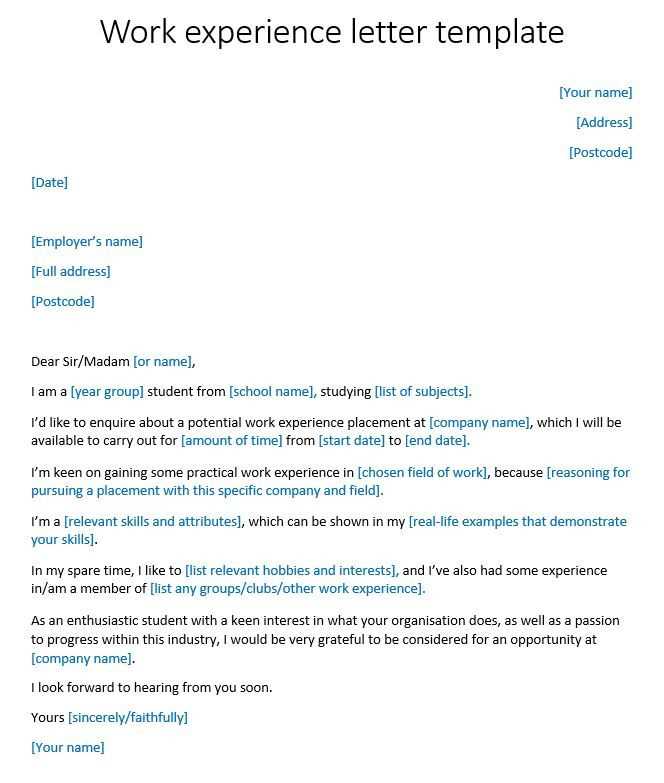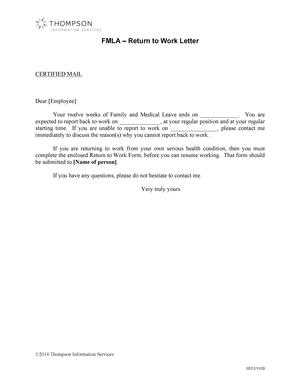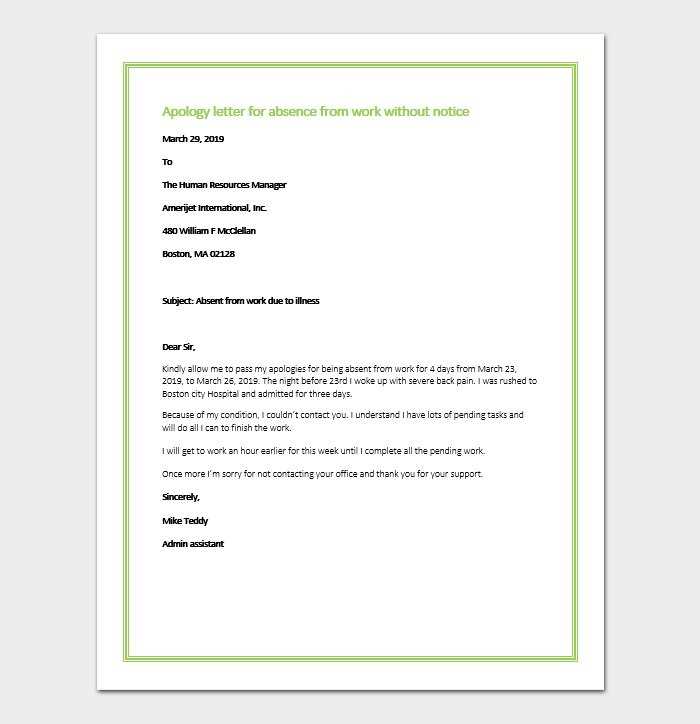Return to Work Letter Template for Employers

Reintegrating an individual into the workforce after a period of absence requires careful attention to detail and clear communication. It is essential to convey important information that will help the individual transition smoothly back into their role. Whether the reason for absence was personal, medical, or otherwise, creating a professional yet supportive message can make a significant difference in the employee’s return experience.
Clear and respectful communication plays a key role in ensuring the process is as seamless as possible. Crafting a message that includes necessary instructions, expectations, and reassurances will help to minimize any uncertainty or stress. A thoughtful approach can also demonstrate the organization’s commitment to the employee’s wellbeing and professional development.
In this section, we will explore how to draft a message that covers all necessary points. The goal is to provide a helpful framework that both informs and supports the returning individual while maintaining a positive and welcoming tone.
Why a Return to Work Letter Matters
Effective communication during the reintegration process plays a crucial role in ensuring that both the individual and the organization are aligned. A well-crafted communication helps establish clear expectations, reduces confusion, and sets the tone for a smooth transition back into professional responsibilities. It offers an opportunity to express support, while also laying out the necessary steps and any relevant policies that need to be followed.
Building Trust and Confidence
A carefully structured message can help foster trust between the individual and the organization. When employees feel that their concerns are acknowledged and their wellbeing is considered, they are more likely to approach their return with confidence. Clear communication ensures that both sides are on the same page, which minimizes potential misunderstandings and sets a positive framework for moving forward.
Setting Expectations for Success
Providing all necessary information in advance allows for a smooth and successful re-engagement. This includes not only logistical details, but also emotional reassurance, helping the individual feel welcomed and valued. Clearly outlining any changes, such as modified schedules or additional support, helps the person feel more prepared for the transition ahead.
How to Craft an Effective Message
Creating a thoughtful and well-structured communication is essential to ensure clarity and understanding. The message should be concise, direct, and empathetic, while still providing all the necessary details for a smooth reintegration process. A well-crafted note fosters a sense of professionalism and care, setting the stage for a positive experience upon rejoining.
Include Key Information Clearly
Start by outlining the essential points that need to be addressed, such as expected dates, any adjustments to previous roles, and important policies. Providing clear and specific instructions ensures there is no ambiguity. Be sure to communicate any changes that the individual should be aware of, so they are prepared for their upcoming responsibilities.
Maintain a Supportive Tone

It is important to convey warmth and understanding, especially when someone is returning after a period of absence. A supportive tone helps to alleviate any anxieties and promotes a sense of reassurance. Express your willingness to assist and ensure the individual feels valued, making them feel confident in their ability to reintegrate smoothly.
Understanding Employer Responsibilities

When an individual is preparing to rejoin their position after time away, the organization holds a critical role in supporting a smooth transition. It is the responsibility of the organization to provide clarity, assist with any necessary adjustments, and ensure that the returning individual feels welcomed and equipped for their role. A well-planned approach not only benefits the employee but also contributes to maintaining overall productivity and morale within the team.
Providing Clear Guidance and Information
One of the main duties is to offer comprehensive guidance about any changes, new procedures, or important updates that the returning individual should be aware of. It is essential to communicate policies clearly, address any concerns, and ensure that all relevant details are easily accessible. This helps the person to feel more comfortable and confident in resuming their tasks.
Supporting the Transition Process
Ensuring emotional support is also a key aspect of the process. The organization should demonstrate empathy by acknowledging any challenges the individual may face. This support can range from offering flexible hours to checking in regularly to ensure the person feels comfortable and adequately supported throughout their transition.
Key Information to Include in the Letter
To ensure the message is both comprehensive and effective, it is important to cover all the necessary details that will help the individual reintegrate successfully. Clear communication of the expectations and any changes is essential. Including the right information provides both clarity and a sense of preparedness, reducing uncertainty as the individual prepares to resume their role.
Dates and Timing Considerations
Clearly stating the agreed-upon date for resuming responsibilities is a critical part of the communication. This should also include any necessary scheduling adjustments, such as modified hours or a phased return if applicable. By outlining the timeline in detail, both the individual and the organization can stay aligned on expectations.
Details of Role and Responsibilities
Another key point is to outline any changes to the individual’s previous duties. If there are any modifications to the scope of work, updated procedures, or new responsibilities, these should be clearly communicated. Providing this information in advance will help the individual adjust without surprises and feel confident in their role. Transparency here is crucial for a smooth transition.
Handling Special Circumstances in Letters
In some cases, the individual’s return might involve unique circumstances that require careful consideration. These situations could include medical needs, personal challenges, or accommodations related to disability or family matters. It is crucial to address such issues thoughtfully, providing the necessary adjustments while maintaining professionalism and support. Tailoring the communication to reflect these specifics ensures the individual feels heard and valued.
Addressing Medical or Health-Related Needs

If the individual’s absence was due to health-related issues, it is important to acknowledge their situation with empathy. The communication should include any necessary modifications to their responsibilities or working conditions to accommodate their recovery. Key points to address may include:
- Flexible scheduling or reduced hours
- Any adjustments to the physical workspace
- Support for medical appointments or treatments
Accommodating Family or Personal Matters
For those returning due to personal or family reasons, clear communication about any required flexibility is also important. This could involve adjusting the return process or providing assistance with time management. Some points to consider when addressing these situations are:
- Providing information on leave options if needed
- Offering support in managing work-life balance
- Being open to potential changes in work hours or location
Best Practices for Letter Delivery
Once the communication is carefully crafted, it is essential to ensure it is delivered in the most appropriate and effective way. The method of delivery plays a significant role in how the message is received and interpreted. Timeliness, format, and the medium used can impact the individual’s experience and response. Ensuring that the message is both clear and accessible is key to a smooth process.
Choosing the Right Method of Delivery
The delivery method should be chosen based on the nature of the communication and the preferences of the individual. For formal messages, email is often the most efficient option, allowing for a quick and easily accessible record. However, in certain situations, a physical copy may be preferred, especially if the message includes sensitive information or requires a more personal touch. Regardless of the method, ensure that the delivery is timely and appropriate for the situation.
Ensuring Clarity and Accessibility
Making the message easy to read and understand is critical. Use clear language and avoid unnecessary jargon that could cause confusion. Additionally, offering the option for further discussion or clarification, whether through a follow-up phone call or meeting, can help ensure that all questions are addressed. Accessibility of the message is also important–consider whether the individual has any specific needs that may require alternative formats, such as larger print or digital access.